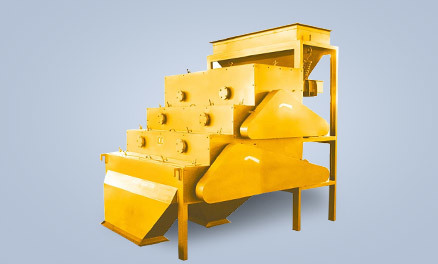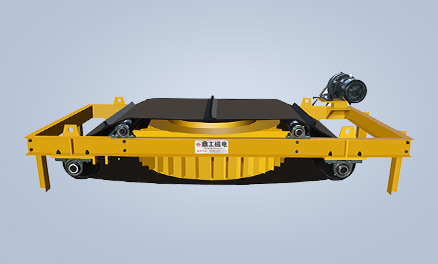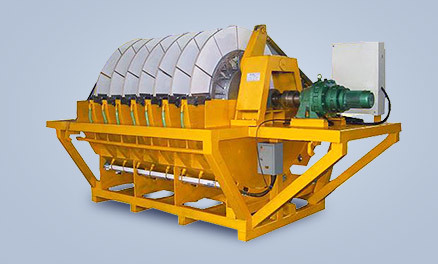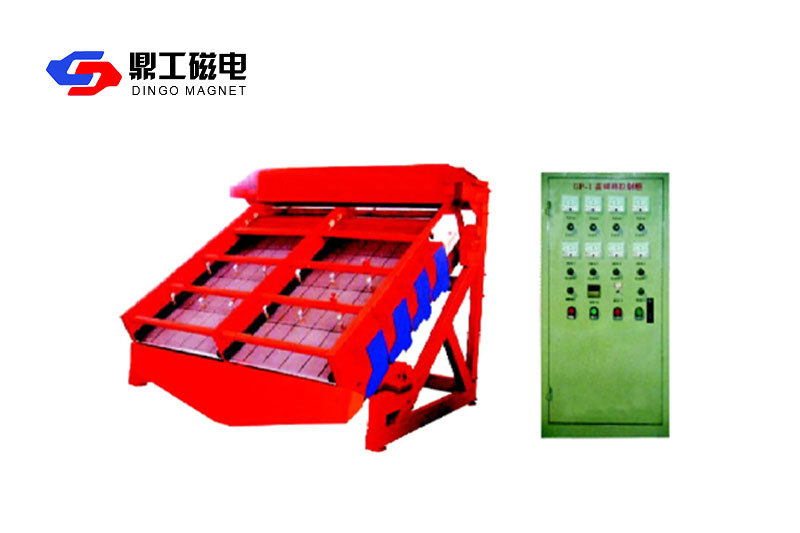PRODUCTS
GPWS series high-frequency vibrating screen
Category:
Tel:
Email:
GPWS series high-frequency vibrating screen
High frequency vibrating screen, abbreviated as high-frequency screen, is composed of components such as exciter, slurry distributor, screen frame, frame, suspension spring, and screen mesh. High frequency vibrating screen is the most important screening machine in the mineral processing industry. It is used to separate solid and crushed ores, with a particle size of approximately 200 μ m. Suitable for completely wet and dry raw materials. The frequency of the vibrating screen is mainly controlled by an electromagnetic vibrator installed above the vibrating screen and directly connected to the surface of the vibrating screen. Its high-frequency characteristics make it different from ordinary vibrating screens. High frequency vibrating screens typically operate at an inclined angle, traditionally ranging from 0 to 25 degrees, with a maximum of 45 degrees. In addition, it should operate on low stroke with a frequency range of 1500-7200 rpm.
High frequency vibrating screen (HFS) has high efficiency, small amplitude, and high screening frequency.
Different from the principle of ordinary screening equipment, the high-frequency vibrating screen (HFS) uses high frequency, which on the one hand disrupts the tension on the pulp surface and the high-speed oscillation of fine-grained materials on the screen surface, accelerates the separation of high-density useful minerals, and increases the probability of materials smaller than the separated particle size coming into contact with the screen hole. This results in better separation conditions, allowing materials smaller than the separation particle size, especially those with larger proportions, to pass through the sieve pores together with the slurry and become the products under the sieve.
The high-frequency vibrating screen adopts a cylindrical eccentric shaft exciter and a partial block to adjust the amplitude. The material screening line is long, and there are multiple screening specifications. It has the characteristics of reliable structure, strong excitation force, high screening efficiency, low vibration noise, durability, convenient maintenance, and safe use. The high-frequency vibrating screen is widely used for product grading in industries such as mining, building materials, transportation, energy, and chemical engineering.
High frequency vibrating screen structure: mainly composed of screen box, exciter, suspension (or support) device, and electric motor. The electric motor drives the main shaft of the exciter to rotate through a triangular belt. Due to the centrifugal inertia force of the unbalanced weight on the exciter, the screen box vibrates. By changing the eccentric weight of the exciter, different amplitudes can be obtained.
Applicable scope
The GPWS series high-frequency vibrating screen is a screening machine that adopts digital electronic control and electromagnetic excitation principles. Suitable for dry and wet screening, grading, and dehydration of various materials.
Technical characteristics
1. The high-frequency vibration of the screen surface can reach 8-10 times the gravitational acceleration, which is 2-3 times the vibration intensity of a general vibrating screen, and the screening efficiency can reach over 80%.
2. The screen surface adopts a 3-layer stainless steel wire textile mesh, and the mesh size is determined according to the screening process requirements. The composite mesh has a high opening rate, greatly improving the service life of the screen.
3. The vibration parameters of the screening machine are controlled by a microcomputer, and the vibration parameters of each vibration system can be programmed in software. Regular intermittent instantaneous strong vibration is used to clean the screen mesh at any time and keep the screen holes unblocked.
4. Low excitation power consumption, closed operation, energy-saving and environmentally friendly products.
5. This type of screening machine can be divided into two types: single-layer screening and double-layer screening, and can be matched with various combinations according to specific application scenarios, with flexible design.
Main factors affecting high-frequency vibrating screens
The main factors affecting high-frequency vibrating screens and other screening machinery are the technical and economic indicators of the screening process, namely screening efficiency and productivity. The former is a quality indicator, while the latter is a quantity indicator. There is a certain relationship between them, and it is also related to many other factors, which determine the results of screening. The factors that affect the screening process can be broadly divided into three categories:
Physical properties of screened materials
This includes the particle size composition, humidity, mud content, and particle shape of the material itself.
When the content of fine particles in the material is high, the productivity of the sieve is also high. When the humidity of the material is high, the screening efficiency generally decreases. However, the larger the sieve size, the smaller the impact of moisture. Therefore, for wet materials with high moisture content, in order to improve the screening process, it is generally possible to increase the sieve size or use wet screening. Materials with a high mud content (when the mud content is greater than 8%) should be screened through wet screening or pre washed.
The Influence of Sieve Surface Properties and Structural Parameters
The linear high-frequency vibrating screen makes particles and the screen surface move vertically, resulting in high screening efficiency and large production capacity. The relative motion between particles and the screen surface is mainly parallel to the bar screen, planar high-frequency vibrating screen, cylindrical screen, etc., which have low screening efficiency and production capacity.
For a certain material, the productivity and screening efficiency of the sieve are determined by the size of the sieve opening. The productivity depends on the width of the screen surface, which has a high productivity. The screening efficiency depends on the length of the screen surface, which has a high screening efficiency. The general aspect ratio is 2.
The larger the effective sieve area (i.e. the ratio of sieve pore area to the entire sieve surface area), the higher the productivity and screening efficiency per unit area of the sieve surface. The larger the mesh size, the greater the productivity per unit sieve surface and the higher the screening efficiency.
The impact of production conditions
When the load of the sieve is large, the screening efficiency is low. To a large extent, the flatness of a circular high-frequency vibrating screen depends on the size of the sieve aperture and the overall screening efficiency; The larger the mesh size, the lower the screening efficiency required, and the higher the productivity.
The uniformity of feeding is of great significance for the screening process.
The inclination angle of the sieve should be appropriate and generally determined through experiments. Furthermore, the amplitude and vibration frequency of the sieve are related to the structural properties of the sieve. Within a certain range, increasing vibration can improve the screening index.
Construction characteristics and maintenance methods
1. During normal operation of the equipment, the feed concentration of the sieve should be frequently observed to control the concentration at around 40% in order to improve classification efficiency.
2. Due to the high classification efficiency, good dehydration performance, and high concentration of the ore slurry on the sieve, the flowability of the ore slurry in the screening chute is poor. Therefore, a water pipe should be installed.
3. The electromagnetic exciter and control box should be strictly protected from water to avoid short circuits. Cover the exciter with a rubber plate to prevent water and slurry from falling in, causing short circuits and blocking the air gap.
4. Check at any time whether the bolts in each part are loose, and whether the screen frame collides with the chute, etc.
5. Always pay attention to the ammeter pointer not exceeding the rated value. When the screen machine is running for about half a month, the current should be adjusted to the rated value (usually 8-9A) and vibrated for 4-5 minutes to remove any objects on the back of the screen.
6. The excitation current (amplitude) can be adjusted according to the ore properties and operational requirements. In order to ensure that the sieve operates at the highest efficiency, an excitation current condition test can be conducted.
7. After one month of use, remove the sieve and perform a 180 ° turn to enhance the "cutting" effect of the sieve strip, in order to improve classification efficiency.
8. When the slurry fed into the sieve by the cloth hopper is sprayed too far, the position or angle of the sieve frame should be adjusted in a timely manner to avoid affecting the classification efficiency.
Product parameters
| Model parameters | Screening area (m²) | Feed concentration (%) | Processing capacity (T/H) | Power (kW) | Screen surface angle | Overall dimensions |
| 2020 | 4 | 30-40 | 15-25 | 1.2-3 | 20-26 | 2400×2600×2600 |
| 2024 | 5 | 30-40 | 20-30 | 1.2-3 | 20-26 | 2400×2900×2600 |
| 2424 | 6 | 30-40 | 24-36 | 1.5-3.5 | 20-26 | 2850×2900×2600 |
Related Products







